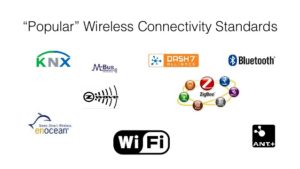- Wi-Fi HaLow – The Wi-Fi Alliance has come out with HaLow, the indoor Wi-Fi format for IoT which uses 900MHz to improve indoor coverage. It will also have better battery life. 900MHz has less spectrum, but remember that most devices send very short message with data and control information. This is why video is not considered part of IoT but it will be expected to run on normal Wi-Fi. The problem with normal Wi-Fi will be battery life. However, Wi-Fi for normal IoT apps will be the most commonly accepted but security may be an issue. The idea here is that the 900MHz will not be running all the time so it will only wake up your device when it has to, not running on 2.4GHz and 5.8GHz which is probably running all the time.
- Bluetooth – They are trying this but there are connectivity issues, range issues, and reliability issues. So far it’s not really taking off. Battery life is still an issue.
- Bluetooth Smart – low energy Bluetooth to improve the battery life of devices and to improve the IoT connections. Peer to peer, short-range, 2.4GHz,
- Z-Wave – proprietary protocol owned by Sigma Designs, 40Kbps and 9.6Kbps and 100Kbps, up to 4 hops, up to 40meters, 908.42Mhz in US, using 20Khz to 110 kHz of bandwidth,
- Thread – a type of indoor low power mesh network that many devices used that are made by NEST. They basically have their own equipment on this 802.15.4 format.http://threadgroup.org/
- ZigBee – Indoor format, mesh, 802.15.4, open standard if you join the ZigBee alliance, normally 10-30 nodes but in theory could do up to 2,000 nodes. 20Kbps in 868MHz band, 40Kbps in 915MHz band, 250Kbps in 2.4GHz band, less than 400m range, longer range lowers battery life
- DECT ULE – Indoor format, Ultra Low Energy using Digital Enhanced Cordless Telecommunications protocol, less than 50m range, up to 1Mbps, up to 400 devices on the network, 1920 to 1930MHz in USA and Canada
- Sigfox UNB – outdoor, Sigfox Ultra Narrow Band, 3GPP GERAN, average range 30 to 50Km depending on-line of site, 928MHz in USA, 150mWatt unit in the USA, used in older devices
- Semtech’s LoRa – Long Range, outdoor protocol, Open Source, STAR topology, no upper limit on devices, 300bps at long-range typically 1Kbps, 2-5Km range, 80MHz with 125 kHz bandwidth. Low-power sensors can be used in streetlights, gas cylinder level sensor, parking sensors, etc.
- LTE – outdoor format, this could be in any LTE band but the problem with LTE is that it’s made for large packets, so there is development underway for smaller bandwidth applications. Ideal format for wide area because every carrier has LTE but needs to improve battery life if a remote device is not connected to power.
Resources:
http://www.lprs.co.uk/assets/media/Rethink%20IoT%20Wireless%20Market%20overview.pdf
http://www.3gpp.org/news-events/3gpp-news/1607-iot
http://www.wired.com/2016/01/wifi-halow-internet-of-things/
http://www.techrepublic.com/article/802-11ah-wi-fi-protocol-for-iot-solves-two-m2m-problems/
http://electronicdesign.com/iot/understanding-protocols-behind-internet-things

